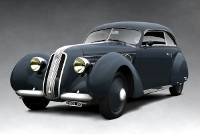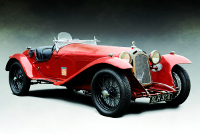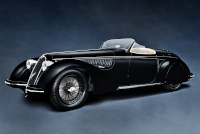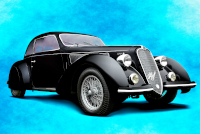Location:
Pebble Beach Concours d'Elegance, 2009
Owner: Pietro Navone | Madrid, Spain
Prologue:
Chassis #813812 is a Milan show car built on an exclusive 6C chassis, and the coachwork exhibits ornamental details also put to glorious use on the Lancia Astura Cabriolet Tipo Bocca. The car exemplifies a very specific Pinin Farina design lexicon, and yet I sense that a peculiar forgotten aura has dragged on the car in spite of its few high-profile outings. Portions of the chassis and coachwork both suffered disassembly and became lost through the 20th century, but we believe the car to be correct in its reconstruction. In this case, the design significance is perhaps greater than the car's material value.
Although these are old illustrations, this gallery has long been one of my favorites. The strength of Modernist design demands proper attention to its details so that the exercise becomes more composition than automotive survey. Early in this project, I did not find that approach so easy, and yet classic Pinin Farina design is an irrefutable force when consumed for the sake of art.
I also found the good fortune to spot the car with its owners nearby, who were lovely people. While showing the car to the judges, they took care to notice that I was photographing. I normally like to stay out of the way, but they were positively inviting, which made possible the inside-out shots seen here.
As they and the car hail from the European continent, I find it remarkable to include chassis #813812 in our Alfa Romeo portfolio.
- - - - - - - - - -
► Image Source: Nikon D200 (10.2 MP)
References:
- MotorSport Magazine, "British Successes on the Pescara Circuit" September, 1935
- Bonhams: Included here is the 2015 auction listing for chassis #813812 from Paris in 2015, with information and photographs.
- UltimateCarPage: Our favorite site profiles this unique 6C 2300B with images from Paris and Villa d'Este, by Wouter Melissen, May 5, 2008.
- Carrozzieri Italiani: A more recent sample of survey photos from a source dedicated to Italian coachwork.
A unique car designed with a passionate sense for Art Deco fashion, moulded with the aerodynamic principles of Paul Jaray, Pinin Farina built chassis #813812 for the 1937 Salone dell'Automobile in Milan.
Though predominately a design exercise, #813812 is an Alfa Romeo. And so, shortly after World War II ended, the car competed in a small number of races, the most notable of which may have been the 1949 Coppa d'Oro delle Dolomiti.
Once a show car and sometimes a racer, the post-War era brought upon this Alfa a strange conversion. Around 1954, someone of a utilitarian persuasion transformed chassis #813812 into a pickup truck. At the time, the original motor disappeared in favor of a slightly less-aged, single-carburetor 6C 2500 unit, and then the entire kit was converted to run on methane gas.
This episode illustrates the neglect Michel Dovaz described in response to his detractors, a reference to criticism over the Sleeping Beauties collection, which Dovaz defended by noting how many automobiles he preserved at a time when doing so was not fashionable. He did save many grand cars from this category of wayward fate.
But all was not lost for this Pinin Farina Speciale. By 1992, after old cars once again became fashionable, the Alfa was rediscovered and recognized as the 1937 Milan show car. However, restoration did not commence until ten years later. The present motor is now a correct Pescara specification unit, though not original. Much of the aerodynamic tail coachwork needed refabrication, as well as the ash frame underneath. But the front half of the coachwork had been kept with the car during its pickup truck reconfiguration, as well as the skirted rear fender sections.
The 6C 2300B platform is itself a well conceived example of modern automotive engineering. With the 'B' designation, Alfa Romeo updated the car's box-section chassis with fully independent front and rear suspension—the front uses double wishbones with coil springs over hydraulic shocks, while the rear uses a swing axle setup. Based on the 1934 platform, the Pescara is a select variant, the name given to cars fitted with twin-carb, high-compression motors. These cars competed on the Targa Abruzzo in Pescara, Italy, winning against more powerful competition, hence the demonym. Chassis #813812's origin as a unique Art Deco show car with competition pedigree makes its history all the more enticing, while also representing how old sports cars fell out of favor during the course of the 20th century.
Alfa Romeo would replace the Pescara the same year, 1937, with a short chassis version, uprated at 105 horsepower and clothed in Touring Superleggera coachwork. That car would become the 6C 2300B Mille Miglia.
Motor: 2,309 cc straight 6-cylinder, cast iron block, light alloy hemi-head | 78 mm x 100 mm | 7.8:1 compression
Valvetrain: DOHC, 2 valves per cylinder
Aspiration: twin Weber carburetors
Power: 95 bhp @ 4,500 rpm
Drivetrain: 4-speed gearbox, rear-wheel drive
Front Suspension: independent double wishbones with coil springs over hydraulic shock absorbers
Rear Suspension: independent swing axles with trailing arms, torsion bars, and hydraulic shock absorbers
Architecture: steel box-section chassis, ash frame, aluminum body by Pinin Farina of Cambiano
Kerb Weight: 1,380 kg (3,042 lbs)
Wheelbase: 3,000 mm (118.1 inches)
Top Speed: 170 km/h (105 mph)
Etymology:
'6C 2300' refers to the motor configuration, a straight 6-cylinder of about 2.3 litres displacement. The 'B' designation indicates that this is the second series of the 6C 2300. Alfa gave the name 'Pescara' to a small number of 6C 2300 cars fitted with a high-compression head and twin carburetors, choosing the name in honor of the 1934 Targa d'Abruzzo, a 24-hour race in which the 6C 2300 swept the podium. This victory was, in fact, just the second race of the young Scuderia Ferrari. The route itself was traversed Pescara and measured 16 miles. 'Berlinetta' refers to the body style, a closed coupe. 'Speciale' refers to the car's unique coachwork and cabin appointments, constructed by Carrozzeria Pinin Farina for the 1937 Salone dell'Automobile in Milan.
Figures:
Alfa Romeo built approximately 1,600 examples of the 6C 2300. Of the 6C 2300 there are three basic configurations: a long wheelbase Turismo, a short wheelbase Gran Turismo, and a sportier version of teh Gran Turismo called the Pescara. Alfa Romeo built 60 cars to Pescara specification. Of those 60, this Milan show car by Pinin Farina is unique.
Value:
Chassis #813812 ventured to auction in Paris early in 2015, yet failed to sell with an estimate between $880,000 and $1.5 million.
Art Deco: Classic Era Design Features on the Pinin Farina Pescara Speciale
As surely as the chrome strake signifies some superfluous assignation between art and industrial design, so does this Alfa Romeo serve the arts before transportation. Nine bold lines run from the lower edge of the grille, up over the nose, and along the central hinge of the bonnet. Three chrome strakes diverge on gentle radii across each of the bonnet sides, abbreviating the middle line, before three chrome circles of increasing diameter fill the outside points. Much less of a statement, three stylized chrome lines accent each rear wheel skirt.
A subtle crown graces the front brow of the hood, just above the windscreen. This gentle feature continues the speedline theme established by the chrome strakes, echoed by the split windscreen. A sublime detail, the crown also pairs the more noticeable creases that bound over the front fenders. Down the car's gently sloping fastback body emerges a narrow tail fin. The fin does not extend very far from the car's silhouette, confined to the length of the boot lid, but it is an odd remark upon early aerodynamic ideas. Pressed disc wheels finish the ensemble, creating a car that borrows heavily from the Paul Jaray school of aerodynamics.
The abbreviated front guards divide on either side of the grille, which wouldn't serve much practical use but look stunning for how they leave the grille clear of distraction. Scant running gear also leaves the flanks clear of obstruction to the cabin, a nod to the automobile's modernization as running boards and fenders blend into the body. Here, a set of five chrome strakes ornament the thin boards, three to the front and two to the rear, augmenting the two-piece guards up front.
Color Detail: Notes on Period Alfa Romeo Paint
Chassis #813812 wears a luxurious shade of grey, tinted with a deep teal. The motor bay, block, and steering column wear an antique sea green. Remembering that this is a Milan show car, the pleasantness of mechanical finishes would be of consequence. In this respect, note that the seat on which the bonnet rests when closed is lined with wood.
Cabin Detail: Pinin Farina Interior Appointments
While the car carries the same luxurious paintwork inside, the cabin presents no lack of soft materials. The floors are fully carpeted, and piped along all seams. The seats are finished in a svelte tweed upholstery. Both the interior door panels and the forward bulkhead posts to either side of the dashboard use this same rich fabric, and the craftwork on the door panels looks particularly luxurious.
Last Updated: Mar 26, 2025











